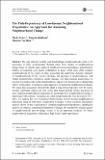Files in this item
The path-dependency of low-income neighbourhood trajectories : an approach for analysing neighbourhood change
Item metadata
| dc.contributor.author | Zwiers, Merle | |
| dc.contributor.author | Kleinhans, Reinout | |
| dc.contributor.author | Van Ham, Maarten | |
| dc.date.accessioned | 2016-06-07T09:30:07Z | |
| dc.date.available | 2016-06-07T09:30:07Z | |
| dc.date.issued | 2017-09 | |
| dc.identifier | 243264969 | |
| dc.identifier | 8f4fcb1f-09a7-437c-96c1-b8da0dfc0d28 | |
| dc.identifier | 84969922387 | |
| dc.identifier | 000407365300003 | |
| dc.identifier.citation | Zwiers , M , Kleinhans , R & Van Ham , M 2017 , ' The path-dependency of low-income neighbourhood trajectories : an approach for analysing neighbourhood change ' , Applied Spatial Analysis and Policy , vol. 10 , no. 3 , pp. 363-380 . https://doi.org/10.1007/s12061-016-9189-z | en |
| dc.identifier.issn | 1874-4621 | |
| dc.identifier.other | RIS: Zwiers2016 | |
| dc.identifier.other | ORCID: /0000-0002-2106-0702/work/64697549 | |
| dc.identifier.uri | https://hdl.handle.net/10023/8944 | |
| dc.description | The research leading to these results has received funding from the European Research Council under the European Union’s Seventh Framework Program (FP/2007-2013) / ERC Grant Agreement n. 615159 (ERC Consolidator Grant DEPRIVEDHOODS, Socio-spatial inequality, deprived neighbourhoods, and neighbourhood effects) and from the Marie Curie program under the European Union’s Seventh Framework Program (FP/2007-2013) / Career Integration Grant n. PCIG10-GA-2011-303728 (CIG Grant NBHCHOICE, Neighbourhood choice, neighbourhood sorting, and neighbourhood effects). | en |
| dc.description.abstract | The gap between wealthy and disadvantaged neighbourhoods seems to be increasing in many contemporary Western cities. Most studies of neighbourhood change focus on specific case-studies of neighbourhood downgrading or gentrification. Studies investigating socio-spatial polarisation in larger urban areas often compare neighbourhoods at two points in time, neglecting the underlying dynamic character of neighbourhoods. In the current literature, the question if neighbourhoods with similar characteristics experience similar changes over time remains unanswered. As a result, it is unclear why some neighbourhoods appear to be more prone to change than others. In this paper, we propose a dual approach for analysing neighbourhood change. We argue that researchers should both adopt a long-term perspective (20–40 years), because significant changes are only visible after longer periods of time, and focus on more detailed neighbourhood trajectories to understand how neighbourhood change is interrelated with context. Focussing on Dutch neighbourhoods over the period 1971–2013, we analyse the role of physical characteristics on low-income neighbourhood trajectories using an innovative visualisation technique. A tree-structured discrepancy analysis allows for the visualisation of complete neighbourhood pathways, enabling the analysis of complex, contextualised patterns of change. We find that the original quality of neighbourhoods and dwellings seems to be an important predictor for future neighbourhood trajectories, indicating a high level of path-dependency. | |
| dc.format.extent | 18 | |
| dc.format.extent | 724075 | |
| dc.language.iso | eng | |
| dc.relation.ispartof | Applied Spatial Analysis and Policy | en |
| dc.subject | Neighbourhood change | en |
| dc.subject | Spatial patterns | en |
| dc.subject | Longitudinal | en |
| dc.subject | Sequence analysis | en |
| dc.subject | Tree-structured discrepancy analysis | en |
| dc.subject | GE Environmental Sciences | en |
| dc.subject | GF Human ecology. Anthropogeography | en |
| dc.subject | NDAS | en |
| dc.subject | SDG 11 - Sustainable Cities and Communities | en |
| dc.subject.lcc | GE | en |
| dc.subject.lcc | GF | en |
| dc.title | The path-dependency of low-income neighbourhood trajectories : an approach for analysing neighbourhood change | en |
| dc.type | Journal article | en |
| dc.contributor.sponsor | European Research Council | en |
| dc.contributor.institution | University of St Andrews. Geography & Sustainable Development | en |
| dc.identifier.doi | 10.1007/s12061-016-9189-z | |
| dc.description.status | Peer reviewed | en |
| dc.identifier.grantnumber | ERC-2013-CoG | en |
This item appears in the following Collection(s)
Items in the St Andrews Research Repository are protected by copyright, with all rights reserved, unless otherwise indicated.

